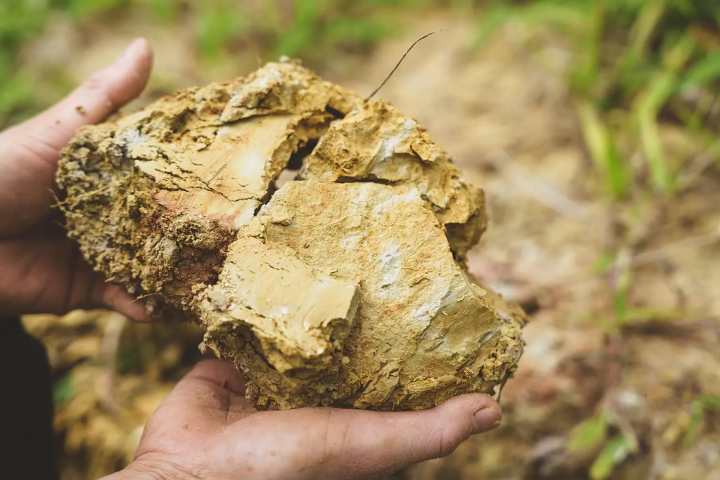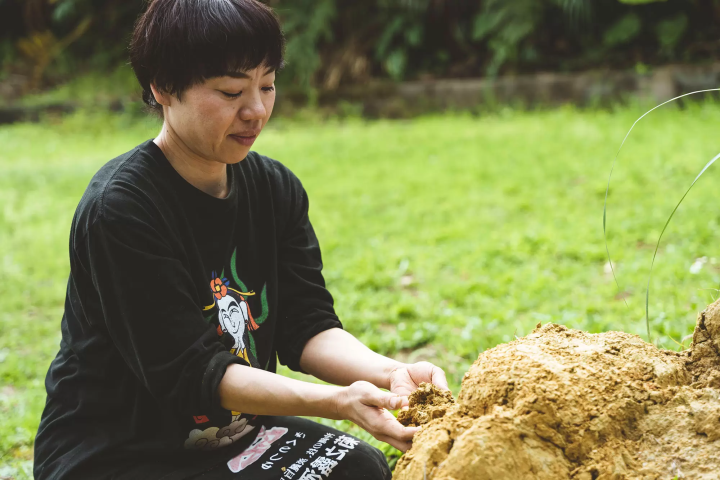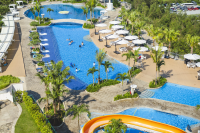"Tableware that returns to the earth" that combines Yambaru soil and Okinawan wisdom

A pair of vases are displayed on either side of the entrance to the club lounge on the lobby floor of the hotel. They are part of a series called "Vessels Returned to Earth" by Nozomi Konno, a potter who works in Yambaru.
"Oriental Hotel Okinawa Resort & Spa" is recommended as a base for sightseeing in Okinawa

Oriental Hotel Okinawa Resort & Spa completed a three-year comprehensive renovation in April 2024.
The hotel's pool and spa are of course attractive, but it also has beds for co-sleeping, a kids' space and pool, and universal rooms, so it's a comfortable hotel for guests of all ages. It's also easily accessible to Junglia Okinawa, which is opening in the north of Okinawa, and Yambaru National Park, making it an easy base for sightseeing in Okinawa, so please use it when you're sightseeing in Okinawa.

A pair of vases is located on either side of the entrance to the Club Lounge on the lobby floor of Oriental Hotel Okinawa Resort & Spa. They are particularly large and have an overwhelming presence in the series entitled "Ceramics Remade Into Soil". The vases are the work of Nobuko Konno, a potter who lives and works in the area called Yambaru in northern Okinawa. The beautiful smooth curves of the surface convey the inherent roughness of the earth and the temperature of the land. What is most distinctive about them is their color and texture. This unique texture is achieved by mixing pig's blood into the clay before firing.
Why did Ms. Konno decide to create "Ceramics Remade Into Soil"? Why did she use pig's blood? We spoke to her to find out her thoughts on creating such original works.
-
Table of Contents
- Blood, the Connection Between Everyday Use and Being Remade into Soil
- It all started with a large pile of failed products. "Can we recycle them somehow?"
- Fire it, crush it, fire it and keep repeating. Until it becomes a piece that can be used everyday.
- The Ceramics Remade Into Soil series is not yet complete. What's the purpose of continuing?
- Have an encounter with something unique to Yambaru and it becomes a memory.
Blood, the Connection Between Everyday Use and Being Remade into Soil

The title of the series, Ceramics Remade Into Soil, is not just an idea, but comes from the fact that the pieces created can actually be recycled into clay. When these pieces have finished their role, they can be returned to nature. The secret lies in the temperature at which the items are fired.
Ms. Konno explains. "This series is earthenware which is fired at a much lower temperature than ordinary pottery. Normally, pottery for daily use is fired at high temperatures to make the clay very hard. The result is a strong vessel that does not leak water, but once hardened, it cannot be returned to its original earthen state. For this series, we have avoided that hardening process and created pottery that can become clay again even after firing."
Ordinary pottery is fired at temperatures of about 1200℃ or higher. The heat shrinks the clay making it hard. And there is a chemical reaction between the components in the clay and the glaze which is applied to the surface of the clay resulting in even further hardening. On the other hand, vessels that are fired at temperatures of 1000℃ or lower can be finished in a state that does not harden. These are called earthenware which are inherently fragile and cannot store water, thereby being unsuitable for everyday use.
Ms. Konno: "I want to make vessels that can be restored into clay. But I want them to be things that can be used properly in daily life, not just objects of art. These two desires are contradictory and it seemed impossible to realize my desire. But I kept thinking about finding a way. And I arrived at the idea of using pig's blood."
In Okinawa, there was a custom of raising pigs in every household. On special occasions, the pig would be slaughtered and everyone would eat together. It was said that, "Everything except the squeal of the pig is edible." Recipes for dishes that use not only the meat but also the bones, organs, and blood have been passed down to the present day.
One day, Ms. Konno learned that pig's blood was used for more than just food in the past. Apparently, the water-repellent properties of blood were used to waterproof the bottoms of boats and nets. Could this property also be applied to pottery? With this in mind, Ms. Konno began her challenge.



It all started with a large pile of failed products. "Can we recycle them somehow?"
Ms. Konno is originally from Osaka. After graduating from high school, she studied pottery at an art university in Okinawa. There she saw a large amount of discarded failed pottery. In other words, the failed pieces became garbage. At the university, the pottery waste generated by 4 years of students was piled up like a mountain, and it made her feel disgusted.
"If I continue studying pottery, I will continue to throw away failed works. Pottery cannot be recycled, so whatever I throw away becomes industrial waste. I wondered how much garbage I would produce before I died. When I thought about that, I couldn't help but wonder if there was not some way to change things."
After graduating from university, Ms. Konno stayed on for one year as an intern. During that time, an acquaintance introduced her to a new kiln that was being built in Yambaru, the northern area of Okinawa. As soon as the wood kiln was completed, she moved her base to Yambaru to begin her pottery activities. Okinawa's geology varies depending on the area. The southern part has soft and brittle soil while the northern areas have a heat-resistant, durable soil making it ideal for pottery making.
Ms. Konno's art works using Yambaru soil and Okinawan materials became popular for their unique colors and textures. She began living a fulfilled artist's life. But she continued to have a desire to make pottery that could be remade into clay. While living in Yambaru, she came into contact with many different people and gathered a variety of information. She finally found that her answer was pig's blood.



Fire it, crush it, fire it and keep repeating. Until it becomes a piece that can be used everyday.
"I won't forget the first time I mixed blood into clay. It turned into a mysterious substance completely different from the clay I was familiar with. I can't put it into words, but my intuition told me that this would work!"
The world had just entered the coronavirus pandemic when she started using this method for making vessels. Looking back, she says it was the perfect timing to stay in her studio and do research. In order to be recyclable, the clay must be fired at a low temperature in order to prevent irreversible hardening. But how low should the temperature be? She even thought it might be better not to fire it at all. The lower the temperature, the more brittle the finished product becomes. And that makes it impractical for everyday use.
"Earthenware is naturally permeable by water. And if the item is only for decoration, it doesn't need to be strong. I wondered if I could create a kind of earthenware that was strong and holds water so that it could be used in modern life. For people who know pottery, that would be a dream come true."
It took a long time of trial and error to create a work that she was satisfied with. The temperature was adjusted many times as the pieces were fired. Any that did not turn out well were crushed and ground in a wooden mortar, and then turned back into clay. This process was repeated endlessly. Sometimes, even pieces that had already been exhibited were returned, crushed, and re-fired. Clay that is fired at the lower temperatures can be re-fired as many times as necessary.




The Ceramics Remade Into Soil series is not yet complete. What's the purpose of continuing?
"I don't think this series is complete yet. Or rather, no one knows what it means to be complete. For example, when it comes to firing blood, even blood experts have never burned blood. Because it is an animal protein, it changes color when exposed to ultraviolet light and it becomes thinner with use. I would like to find ways to strengthen the protein."
There is another difficulty in making Ceramics Remade Into Soil. It is that they can only be made during the winter when the outside temperatures are cool. Blood is a fresh product and cannot be handled in the heat of Okinawa's summer. In recent years, it has become difficult to obtain pig's blood even within Okinawa. The schedule and procedure of making these products is greatly affected by when the raw blood can be obtained. In any case, it's not easy. So why does Ms. Konno want to continue this kind of production?
"If you decide that something is impossible, you will not move forward from there. However, if you keep going, you will eventually find clues to a solution. And if many people begin to see it as possible and they begin to show interest, the chances of finding a good solution increase."

Ms. Konno also shared some of her thoughts on the Okinawan culture where she lives.
"Compared to the old days in Okinawa, pig's blood is used less and less in food and daily life. Even people who were born and raised in Okinawa apparently have never eaten a dish made with blood. If this continues, this part of the culture may eventually disappear. I believe that by creating Ceramics Remade Into Soil, I may be able to provide inspiration, even in a small way, for people to come into contact with Okinawan culture."
Have an encounter with something unique to Yambaru and it becomes a memory.

At Oriental Hotel, Ceramics Remade Into Soil are on display at the entrance to the Club Lounge, inside the lounge, and from spring 2024, in the elevator halls on each floor. The hotel hopes that by seeing these displays, guests will become more interested in Ms. Konno's idea of recycling products. That is the reason these works were selected. In addition, the hotel hopes their own staff will be fascinated by these works of art displayed throughout the property.
"Oriental Hotel values Yambaru culture which can be seen throughout the facility and its décor. When I heard about their concept, I felt it lined up with the theme of my work very nicely. I feel that my work being displayed in this hotel is very meaningful." Ms. Konno continued, "Ceramics Remade Into Soil is a series that I was able to create only because I was in Okinawa. In any other prefecture, I would never have come across information about pig's blood. And even if I had, I would not have been able to obtain it anywhere. Since I am in Okinawa, I want to create things that can only be created here."
The soil of Yambaru, the energy of life, the wisdom and life of the people of Okinawa have been passed down since ancient times. Our hope is that your stay at Oriental Hotel will be a special memory where you are surrounded by the kind of décor that allows you to experience this unique culture.
Nobuko Konno
Born in 1983 in Osaka Prefecture, Ms. Konno attended a pottery experience as part of a high school event and was impressed by the simple phenomenon of turning clay into a vessel by firing it. Her interest sparked, she told her teacher during a career guidance time that she wanted to do pottery. She was advised to leave Kansai and go somewhere like Okinawa which prompted her to apply to Okinawa University of Arts. In 2008, she moved to Yambaru in northern Okinawa and began making her own pottery. She continues to create using Okinawan materials such as Ryukyu indigo with the Yambaru soil as her raw material. She has created many series to date, and each time she creates a new style, it attracts attention. Her most famous series include one which uses Ryukyu indigo and is known as Konno Blue, and another one which uses white-toned coral.

"Oriental Hotel Okinawa Resort & Spa" is recommended as a base for sightseeing in Okinawa
Oriental Hotel Okinawa Resort & Spa completed a three-year comprehensive renovation in April 2024.
The hotel's pool and spa are of course attractive, but it also has beds for co-sleeping, a kids' space and pool, and universal rooms, so it's a comfortable hotel for guests of all ages. It's also easily accessible to Junglia Okinawa, which is opening in the north of Okinawa, and Yambaru National Park, making it an easy base for sightseeing in Okinawa, so please use it when you're sightseeing in Okinawa.


Hotel Management Japan Co., Ltd. is a hotel management company that operates 24 hotels in Japan (total number of rooms: 7,601). In addition to its own brands, "Oriental Hotel" and "Hotel Oriental Express," the company also manages and operates a variety of hotels, including "Hilton," "Sheraton," and "Hotel Nikko."
The contents on this page may partially contain automatic translation.




























![[2026] Top 5 Strawberry Picking Spots in Tokushima, Naruto| Farms and Access Guide for January to May](https://resources.matcha-jp.com/resize/720x2000/2025/03/06-227165.webp)
![[Yamanashi/ Hokuto City] 4 Hot New Spots Opening in 2026](https://resources.matcha-jp.com/resize/720x2000/2025/12/12-252747.webp)


